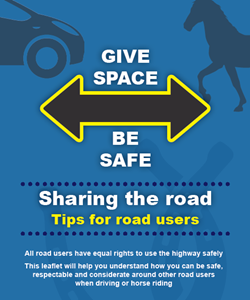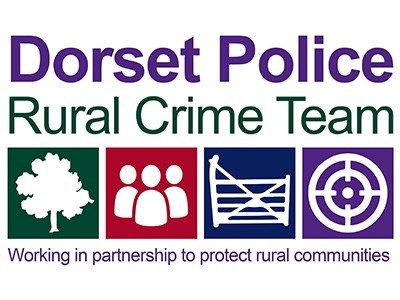Horse Safe
Following the success of Dorset Police’s innovative Operation Close Pass – Cycle Safe which supports bike safety on the highway, the scheme is being extended to include horse riders and other vulnerable rural road users including pedestrians, farm workers, dog walkers, motorcyclists.
Operation Close Pass – Horse Safe follows the same principles as Cycle Safe but is aimed at horse riders and drivers in more rural areas. We rely on public support with regard to incidents and troublesome areas for our operations. Supported through the British Horse Society and launched at Kingston Maurward Equestrian Centre near Dorchester, it advocates mutual respect from all road users whilst keeping our rural communities safer on the roads.
The intentions of this Operation are –
- To promote the safety of horse riders and other vulnerable road users
- To educate and encourage all road users to take responsibility for their own safety while respecting that of others.
- To detect / deter road traffic offences
- To provide public reassurance
This strategy aims to inform and educate all road users, specifically drivers, of the dangers of passing horses too closely. It is recommended that drivers pass wide and slow when passing horses whilst driving. It is suggested that the minimum passing distance when passing a cyclist is at least 2 m when it is safe to do so and we reiterate that it is at least this distance when horses are involved. When police carry out an Operation Close Pass, a plain clothed police officer on a cycle reports to supporting patrol colleagues if a vehicle has passed too closely, and then colleagues re-direct any drivers to a safe stopping place where that distance is very clearly represented on a specially produced mat. We will hold operations in specific areas noted to us by riders as having experienced issues from motorists, therefore we will concentrate motorists’ behaviour within the rural setting.
Drivers are given the option to receive education at the roadside there and then as opposed to a penalty notice for careless and inconsiderate driving. A leaflet is available from the Road Casualty Reduction Officer in Poole as well as local businesses and pony clubs.
Most drivers opt for roadside education and also have the option to view video evidence recorded on cameras fixed to the police officer’s cycle. Drivers do agree that it has made them think more about the gap to leave riders and how vulnerable they, and the unpredictable animal, are!
The leaflet reminds the public that road users have equal rights to use the highway safely and is available to help people understand how to be safe, respectful and considerate around other road users to promote behaviour change. It is packed full of tips for both drivers and horse riders alike. ‘Horse Safe’ will be intelligence led policing and we encourage the public to monitor and notify us of areas of concern where we could potentially visit and run an operation.
Horses on the Highway
With lighter evenings and longer daylight hours now upon us more vehicles, cyclists and equestrians will be using the highway. Both riders and motorists have a right to use the highway however by ensuring this is done safely will ensure that you arrive safely at your destination. Mutual courtesy, consideration and care are key to the safety of all road users.
Advice...
- Look out for the riders' hand signals indicating their intended direction or requesting you to slow down or stop
- Reduce your speed to a maximum of 10 mph when approaching and passing horses
- Be patient and do not sound your horn or rev your engine
- Pass wide and slow giving the horse plenty of room
- Overtake only when it is safe and avoid overtaking on solid white lines or on approach to or when negotiating bends
- Don’t accelerate rapidly once you have passed them
- Do not sound your horn
- On roundabouts, horse riders will keep to the left within the roundabout until approaching their exit, when they will signal left
- Pass horses wide and on the right as you would a vehicle
- Never undercut, pass on the inside
- Don’t ignore the riders request to slow down or stop
- Try to alert the horse rider of your approach. Cycling is a quiet activity and you could startle the horse.
- Wear fluorescent/reflective clothing on both horse and rider whatever the weather and during day light hours
- If at all avoidable, don't ride in failing light, darkness, fog, ice, snow
- If riding a horse that is not used to roads, ask a rider who has an experienced calm horse to accompany you
- If riding two abreast, move into single file as soon as it is safe to enable motorist(s) to overtake
- Do not ride on roads more than two abreast
- Leave details of your intended route and estimated time of return with a responsible person taking a mobile phone with you to you in the event of an emergency
Nationally, 11 horse riders were killed and 116 seriously injured in collisions with motor vehicles between 2010 to 2015.
Think Road Safety
Transporting horses and ponies safely
Always check to ensure the safety of your horse and passengers before you drive.
Good vehicle/trailer maintenance together with checking to ensure your chosen transport is road worthy prior to loading is paramount in ensuring the safety of horses, passengers, and other road users. If you transport a horse/pony in a vehicle which is not safe or fail to correctly load/secure the animal you put yourself, animals and other road users at risk of harm. Routine maintenance and checks are ultimate in ensuring the safety of everyone and your horse.
The following are some checks that should be carried out to your lorry/towing vehicle/trailer every trip prior to loading:
- Tyres are inflated to the correct pressure suitable for your maximum load
- Tyres fitted are fit for purpose and their condition is legal
- Lights and indicators working correctly and they are clean
- Breakaway cable is correctly fitted to vehicle
- Floors and ramps are in safe condition
- Sufficient floor space and height for the animals
- Ramp operates correctly and is secure when in locked position
- Brakes are working correctly
- Weight barring load doesn’t exceed the maximum for the trailer/lorry
- Towing vehicle is fit for purpose
- Horse/pony safely loaded and secure
- You have suitable provision for recovery in the event of an accident/breakdown
Navigation links


